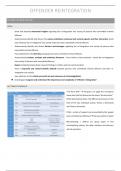Notes de cours
Notities offender reintegration academiejaar 22-23
- Établissement
- Universiteit Gent (UGent)
Een volledig document van de lessen van "selected issues: offender reintegration" in academiejaar 22-23. Ik ben naar elke les geweest en heb hier notities van genomen die in deze samenvatting verwerkt zitten. INHOUD: - les 1: course introduction - les 2: what's in a name - les 3: the import...
[Montrer plus]



